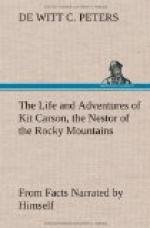quickly made on both sides. Young directed the
greater part of his men to lie in ambush, for he felt
confident that the Indians did not know his strength.
The bands of savages who covered the hills round about
mistook the halt necessary to complete the ambush for
cowardice and fear on the part of the whites.
At this their courage arose, to such a degree, that
they made a bold charge against, as they supposed,
the small party of white men who were visible.
They were allowed to advance well into the trap, until,
by the position of the trappers in ambush, they came
under a cross fire. At the word of command, a
general volley was fired into the advance column.
Fifteen warriors fell dead, and many others were wounded.
The Indians became panic-stricken, and the trappers
immediately following up their advantage, advanced
from cover. The warriors did not rally for a
second attack, but fled in every direction, leaving
Young, with his party, masters of the field.
Strange as it has ever seemed, to the inquiring mind,
in those days and for many succeeding years, companies
of white men from fifty to sixty in number could wage
successful war against whole tribes of Indians, who
could easily muster a thousand fighting men.
A reason often given for this is, that the trappers
of the western wilds are invariably “dead shots”
with the rifle and well versed in Indian strategy.
On the other hand, the red men were, comparatively
speaking, poorly armed, and could not travel together
for any length of time in large parties, because they
depended for food chiefly upon hunting. Had there
existed no other cause, the means of obtaining provision
being limited, must have compelled them to separate.
Very frequently whole tribes are reduced to depend
upon daily hunts. The bravery of the Indians
is of a different stamp from that which is exhibited
by the whites, especially where the white man is a
Simon-pure western trapper. The white man on the
prairie or in the mountains, knows but too well that
if attacked by Indians he must conquer or die.
It was, and is, seldom that a company out on an expedition
has any place of refuge to which it may retreat.
Here is the principal reason why the trapper is so
seldom defeated. He cannot afford to lose his
life to a certainty, and consequently will not allow
a defeat.
After this fight, Young’s party trapped down the Salt River to San Francisco River, and thence on up to the head of the latter stream. The Indians failed not to hover on their pathway, and to make nightly attacks upon their party. Frequently they would crawl into camp and steal a trap, or kill a mule or a horse, and do whatever other damage they could secretly. At the head of the San Francisco River the company was divided. It was so arranged, that one party was to proceed to the valley of the Sacramento in California. Of this detachment Kit Carson was a member. The other party had orders to return to New Mexico for the purpose of procuring traps to




